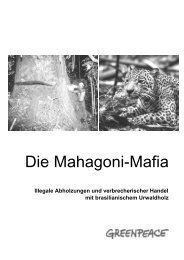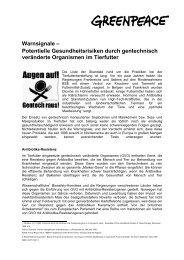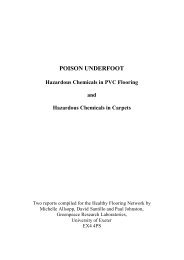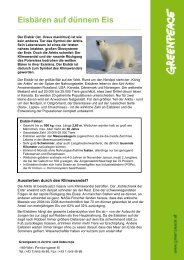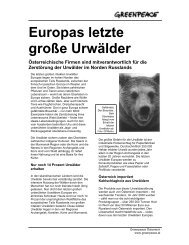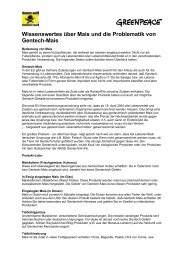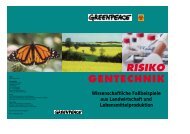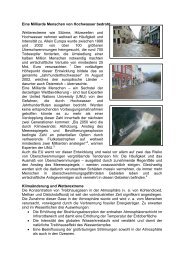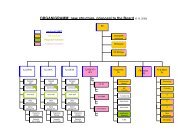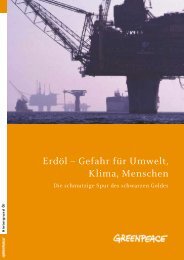Glossary of Fisheries and Aquaculture Terms
Glossary of Fisheries and Aquaculture Terms
Glossary of Fisheries and Aquaculture Terms
You also want an ePaper? Increase the reach of your titles
YUMPU automatically turns print PDFs into web optimized ePapers that Google loves.
Greenpeace in Zentral- und Osteuropa Tel: +43 (1) 5454580<br />
Fernkorngasse 10 Fax +43 (1) 5454588<br />
1100 Wien, Österreich www.greenpeace.at<br />
<strong>Glossary</strong> <strong>of</strong> <strong>Fisheries</strong> <strong>and</strong> <strong>Aquaculture</strong> <strong>Terms</strong><br />
<strong>Aquaculture</strong> Cultivation or farming <strong>of</strong> any aquatic species marine or freshwater,<br />
plant or animal.<br />
Beam trawl<br />
Benthic<br />
Biomass<br />
B MSY<br />
Bottom trawl<br />
Brood stock<br />
Bycatch<br />
Cetacean<br />
CITES<br />
A type <strong>of</strong> bottom trawl in which the horizontal opening <strong>of</strong> the net is<br />
provided by a heavy beam mounted at each end on guides or skids<br />
which travel along the seabed. On s<strong>and</strong>y or muddy bottoms, a series<br />
<strong>of</strong> tickler chains are strung between the skids ahead <strong>of</strong> the net to stir<br />
up the fish from the seabed <strong>and</strong> chase them into the net. On rocky<br />
grounds, these tickers are replaced with chain matting. Used mainly<br />
for flatfish <strong>and</strong> shrimp fishing.<br />
Bottom-dwelling.<br />
The total weight <strong>of</strong> a group (or stock) <strong>of</strong> living organisms or <strong>of</strong> some<br />
defined fraction <strong>of</strong> it (e.g. spawners), in a given area, at a particular<br />
time.<br />
Biomass corresponding to maximum sustainable yield (MSY).<br />
Often used as a biological reference point in fisheries management, it<br />
is the long-term average biomass expected if fishing at the rate <strong>of</strong><br />
F MSY (see Fishing mortality).<br />
A trawl designed to work at the sea bottom. The lower edge <strong>of</strong> the net<br />
opening drags along the seabed, <strong>and</strong> is normally protected by a thick<br />
ground rope <strong>and</strong> ballasted with chains, sinkers, rubber discs, bobbins,<br />
etc. Bottom trawls include low-opening trawls for demersal species<br />
such as beam trawls <strong>and</strong> shrimp trawls, <strong>and</strong> high-opening demersal<br />
otter trawls for semi-demersal or pelagic species.<br />
Eggs, juveniles or adults <strong>of</strong> a species, from which a first or<br />
subsequent generation may be produced in captivity, whether for<br />
growing in aquaculture or for release to the wild for stock<br />
enhancement.<br />
The part <strong>of</strong> a catch other than the adults <strong>of</strong> the target species, which<br />
is taken incidentally. Some or all <strong>of</strong> it may be returned to the sea as<br />
discards, usually dead or dying.<br />
A marine mammal <strong>of</strong> the order Cetacea, including whales, dolphins<br />
<strong>and</strong> porpoises.<br />
Convention on International Trade in Endangered Species <strong>of</strong> Wild<br />
Fauna <strong>and</strong> Flora.<br />
Common <strong>Fisheries</strong> Policy (CFP). The policy under which the EU manages all fisheries within the<br />
European EEZ.<br />
Cold seep<br />
Critically Endangered<br />
Danish seine<br />
An area <strong>of</strong> the seabed where hydrogen sulphide, methane <strong>and</strong> other<br />
hydrocarbon-rich fluid-seepage occurs, <strong>of</strong>ten in the form <strong>of</strong> a brine<br />
pool.<br />
Facing an extremely high risk <strong>of</strong> extinction in the wild in the immediate<br />
future (IUCN definition).<br />
A fishing net with a conical net bag with two relatively long wings. Two<br />
long heavy ropes, one attached to each wing, are used to encircle a<br />
<strong>Glossary</strong> <strong>of</strong> <strong>Fisheries</strong> <strong>and</strong> <strong>Aquaculture</strong> <strong>Terms</strong> 1
Data Deficient<br />
Demersal<br />
Demersal otter trawl<br />
Dredge<br />
Endangered<br />
EU<br />
large area <strong>of</strong> the seabed to herd the fish into the net <strong>and</strong> then to haul<br />
the net in. Used for benthic fish such as flatfish.<br />
Presumed to be at some risk <strong>of</strong> extinction, but there is inadequate<br />
information to make a direct, or indirect assessment <strong>of</strong> this risk based<br />
on its distribution <strong>and</strong>/or population status (IUCN definition).<br />
Of a fish or other organism: living near or on the seabed. Of a fishery,<br />
etc: operating within this zone. Demersal fish include species such as<br />
haddock <strong>and</strong> cod <strong>and</strong> flatfish.<br />
A type <strong>of</strong> bottom trawl with rectangular 'doors' or 'otterboards' to<br />
keep the mouth <strong>of</strong> the cone-shaped net open horizontally while the<br />
net is being towed. A vertical opening is maintained by weights on the<br />
bottom <strong>and</strong> floats on the top. The net is dragged along the sea bed<br />
with the aid <strong>of</strong> bobbins, rollers <strong>and</strong> rockhoppers which can roll across<br />
or dig into the bottom or bounce over obstacles.<br />
Gear used in fishing for shellfish, consisting <strong>of</strong> a rugged triangular<br />
steel frame <strong>and</strong> tooth-bearing bar, behind which a mat <strong>of</strong> linked steel<br />
rings is secured. A heavy netting cover joins the sides <strong>and</strong> back <strong>of</strong><br />
this mat to form a bag in which the catch is retained. Shellfish such as<br />
scallops are raked out <strong>of</strong> s<strong>and</strong> or gravel <strong>and</strong> swept into the bag.<br />
Several dredges are towed together from a tow bar <strong>and</strong> larger vessels<br />
generally tow two bars.<br />
Not Critically Endangered, but facing a very high risk <strong>of</strong> extinction in<br />
the wild in the near future (IUCN definition).<br />
European Union.<br />
Exclusive economic zone (EEZ). The maritime zone under national jurisdiction (up to 200<br />
nautical miles from the coast), within which a coastal state has the<br />
right to explore <strong>and</strong> exploit, <strong>and</strong> the responsibility to conserve <strong>and</strong><br />
manage, the living <strong>and</strong> non-living natural resources.<br />
FAO<br />
Fishing mortality<br />
Fishmeal<br />
Forage fish<br />
Food <strong>and</strong> Agriculture Organisation <strong>of</strong> the United Nations.<br />
(F). The total rate <strong>of</strong> deaths <strong>of</strong> fish directly due to fishing. Usually<br />
expressed as the proportion <strong>of</strong> the entire population caught in a year.<br />
F MSY is the rate which, if applied constantly, results in the maximum<br />
sustainable yield (MSY) <strong>of</strong> fish. F lim is the rate above which<br />
recruitment will decline substantially, usually set as the F MSY . F pa is<br />
the precautionary approach limit set to allow for uncertainty in survey<br />
data <strong>and</strong> to ensure F lim is not reached accidentally.<br />
Protein-rich meal derived from processing whole fish (usually small<br />
pelagic forage fish, <strong>and</strong> bycatch) as well as by-products from fish<br />
processing plants. Used mainly as feeds for poultry, livestock, <strong>and</strong><br />
aquaculture species.<br />
Abundant, schooling species (such as sardines, herrings, Alaska<br />
pollock, menhaden, krill, <strong>and</strong> squid) that are described as fuel for the<br />
food web because they are the food that sustains diverse<br />
assemblages <strong>of</strong> larger predators higher up in the ocean food chain<br />
seabirds, marine mammals, <strong>and</strong> other fish species. 1 Although highly<br />
abundant, their populations fluctuate widely under various<br />
environmental influences. Forage fish were once a relatively small<br />
share <strong>of</strong> the global marine fisheries, but industrial fishing technologies<br />
have enabled the removal <strong>of</strong> ever-growing quantities from the oceans,<br />
with little thought as to the impacts on marine ecosystems. The<br />
Peruvian anchoveta fishery is now the largest in the world (10.7<br />
million tonnes in 2004), <strong>and</strong> seven <strong>of</strong> the top ten fisheries (by weight)<br />
target forage fish. 2 Most <strong>of</strong> these fish are processed directly into<br />
Greenpeace Red Grade Criteria for Unsustainable <strong>Aquaculture</strong> 2
Hydrothermal vent<br />
ICES<br />
Industrial fisheries<br />
IUCN<br />
IUCN Redlist<br />
IUU fishing<br />
Minimum l<strong>and</strong>ing size<br />
fishmeal <strong>and</strong> fish oil to be used in poultry, livestock, <strong>and</strong> aquaculture<br />
feeds.<br />
A fissure in the seabed from which geothermally heated water issues.<br />
International Council for the Exploration <strong>of</strong> the Sea. Scientists working<br />
through ICES gather information about the marine ecosystem. ICES<br />
Advisory Committee develops this information into advice which is<br />
used by the 20 member countries to help them manage resources in<br />
the North Atlantic Ocean <strong>and</strong> adjacent seas.<br />
Fleets <strong>of</strong> large vessels, using highly mechanised means to catch <strong>and</strong><br />
process fish <strong>and</strong> shellfish, particularly for purposes other than human<br />
consumption (e.g. fishmeal, fertilizer).<br />
World Conservation Union (formerly the International Union for<br />
Conservation <strong>of</strong> Nature <strong>and</strong> Natural Resources).<br />
The world's most comprehensive inventory <strong>of</strong> the global conservation<br />
status <strong>of</strong> plant <strong>and</strong> animal species. It is widely considered to be the<br />
most objective <strong>and</strong> authoritative system for classifying species in<br />
terms <strong>of</strong> the risk <strong>of</strong> extinction. Classification groups are: Data<br />
Deficient, Near Threatened, Vulnerable, Endangered, Critically<br />
Endangered, Extinct in the Wild, or Extinct.<br />
Illegal, unreported <strong>and</strong> unregulated fishing. Also known as pirate<br />
fishing.<br />
(MLS). A fishery management control on size at l<strong>and</strong>ing (or in the<br />
market). Intended to minimize the catch <strong>of</strong> small fish or juveniles to<br />
give them a better chance to grow <strong>and</strong> reproduce before being<br />
vulnerable to fishing.<br />
Maximum sustainable yield (MSY). The highest theoretical yield that can be continuously taken<br />
from a stock under existing environmental conditions without<br />
significantly affecting recruitment.<br />
NAFO Northwest Atlantic <strong>Fisheries</strong> Organization. NAFO is an<br />
intergovernmental fisheries science <strong>and</strong> management body. NAFO<br />
Scientific Council gives advice on the status <strong>of</strong> fish stocks in the<br />
NAFO Convention Area to the <strong>Fisheries</strong> Commission <strong>and</strong> Coastal<br />
States.<br />
Near Threatened<br />
Nursery<br />
OSPAR<br />
Overfished<br />
Overfishing<br />
Pair trawl<br />
Pelagic<br />
At a lower risk <strong>of</strong> extinction in the wild but close to qualifying for the<br />
Vulnerable category (IUCN definition).<br />
An area where juvenile fish live <strong>and</strong> grow.<br />
Oslo <strong>and</strong> Paris Convention for the Protection <strong>of</strong> the Marine<br />
Environment <strong>of</strong> the North-East Atlantic<br />
In fisheries science, a stock is considered to be in an overfished state<br />
when it has reached an explicit limit set by management, below which<br />
the population may fall to a level too low to ensure reproduction at a<br />
rate sufficient to maintain it. (Exact definitions vary between<br />
management systems).<br />
In fisheries science, overfishing is occurring when the fishing<br />
mortality has reached an explicit limit set by management, above<br />
which the stock is expected to decline towards an overfished state.<br />
(Exact definitions vary between management systems).<br />
A large pelagic trawl towed between two boats. Associated with<br />
bycatch <strong>of</strong> marine mammals.<br />
Of a fish or other organism: spending most <strong>of</strong> its life in the mid-water,<br />
with little contact with or dependency on the seabed. Of a fishery, etc:<br />
Greenpeace Red Grade Criteria for Unsustainable <strong>Aquaculture</strong> 3
Pelagic trawl<br />
Quota<br />
Recruitment<br />
Reproductive capacity<br />
operating within this zone. Pelagic fish include species such as<br />
herring <strong>and</strong> sardine.<br />
A trawl designed to work in mid-water, targeting pelagic fish. The<br />
front net sections are <strong>of</strong>ten made <strong>of</strong> very large meshes or ropes,<br />
which herd the fish towards the back <strong>of</strong> the funnel-shaped net.<br />
Pelagic trawls may be towed by one or two (pair trawl) boats.<br />
Associated with bycatch <strong>of</strong> cetaceans <strong>and</strong> other marine mammals.<br />
A share <strong>of</strong> the total allowable catch (TAC) for a given fishery,<br />
allocated to an operating unit such as a country, a vessel, a company<br />
or an individual fisherman (individual quota), depending on the system<br />
<strong>of</strong> allocation. Quotas may or may not be transferable, inheritable or<br />
tradable.<br />
The rate at which a population is added to each year. Recruitment to<br />
an exploitable (i.e. mature) stock is generally through growth <strong>of</strong><br />
juvenile individuals <strong>and</strong>/or migration into the stock area.<br />
(RC). A measure <strong>of</strong> a stock s ability to maintain its SSB at a level<br />
below which recruitment will decline substantially. RC is determined<br />
by comparing the SSB to the biomass limit reference point (B lim ) <strong>and</strong><br />
the biomass precautionary approach reference point (B pa ).<br />
Spawning stock biomass (SSB). The total weight <strong>of</strong> all fish in the population which contribute to<br />
reproduction.<br />
Seamount<br />
Stock<br />
Stock status<br />
A mountain rising from the seabed that does not reach to the water's<br />
surface.<br />
A population from which catches are taken by a fishery. A stock is<br />
usually defined in terms <strong>of</strong> a particular population more or less<br />
isolated from other populations <strong>of</strong> the same species <strong>and</strong> hence selfsustaining.<br />
Assessment <strong>of</strong> the situation <strong>of</strong> a stock. The FAO express this as:<br />
protected, under-exploited, intensively exploited, fully exploited, overexploited,<br />
depleted, extinct or commercially extinct.<br />
Suction/hydraulic dredge Water is shot into sediments <strong>and</strong> displaced shellfish are collected the<br />
in a mesh bag (hydraulic) or sucked to the surface through a pipe<br />
(suction).<br />
Total allowable catch<br />
Trawl<br />
Tropic level<br />
Vulnerable<br />
(TAC). The catch allowed to be taken from a resource in a specified<br />
period (usually a year), as defined in the management plan. The TAC<br />
may be allocated to the stakeholders in the form <strong>of</strong> quotas, as<br />
specific quantities or proportions <strong>of</strong> the TAC.<br />
A funnel-shaped net that is towed through the water by one or more<br />
vessels.<br />
The position that an organism occupies in a food chain, i.e. what it<br />
eats, <strong>and</strong> what eats it.<br />
Not Critically Endangered or Endangered, but facing a high risk <strong>of</strong><br />
extinction in the wild in the medium-term future (IUCN definition).<br />
1 Marine Fish Conservation Network (2008). Forage Fish. www.foragefish.org website. Marine Fish Conservation<br />
Network, Washington, DC, USA. Accessed April 2008 at: http://www.foragefish.org/index.html<br />
2 FAO (2007). The state <strong>of</strong> world fisheries <strong>and</strong> aquaculture 2006 (SOFIA). Biennial report. Food <strong>and</strong> Agriculture<br />
Organization <strong>of</strong> the United Nations (FAO), Rome, Italy. Accessed April 2008 at:<br />
http://www.fao.org/docrep/009/A0699e/A0699e00.htm<br />
Greenpeace Red Grade Criteria for Unsustainable <strong>Aquaculture</strong> 4


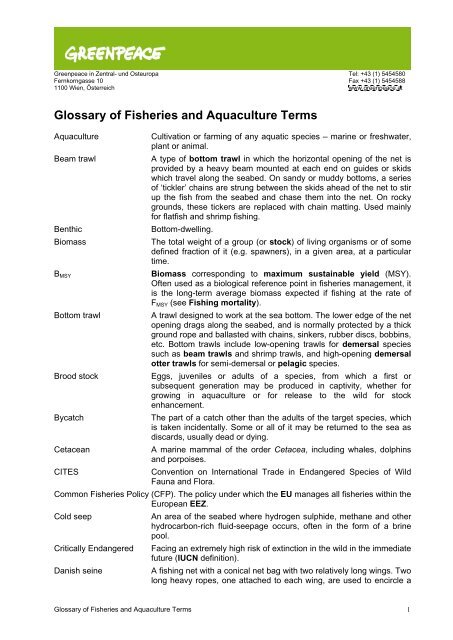
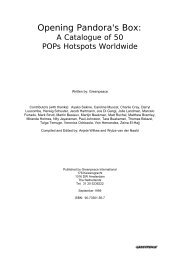
![3. Die Energie-[R]evolution](https://img.yumpu.com/22078498/1/184x260/3-die-energie-revolution.jpg?quality=85)
